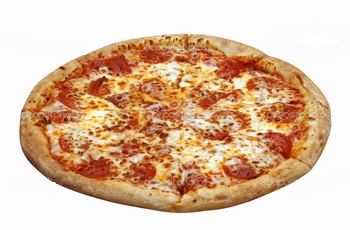|
Pizza is an oven-baked flat bread generally topped
with tomato sauce and cheese. It is commonly
supplemented with a selection of meats, vegetables
and condiments. The term was first recorded in the
10th century, in a Latin manuscript from Gaeta in
Central Italy. The modern pizza was invented in
Naples, Italy, and the dish and its variants have
since become popular in many areas of the world.
In 2009, upon Italy's request, Neapolitan pizza was
safeguarded in the European Union as a Traditional
Speciality Guaranteed dish. The Associazione Verace
Pizza Napoletana (the True Neapolitan Pizza
Association) is a non-profit organization founded in
1984 with legal and operational headquarters in
Naples.
Its mission is to promote and protect the "true Neapolitan
pizza" defined as the product made in accordance with the
International Regulations for the brand.
Pizza is sold fresh, frozen or in portions. Various types of
ovens are used to cook them and many varieties exist.
Several similar dishes are prepared from ingredients
commonly used in pizza preparation, such as calzone and
stromboli.
The origin of the word pizza is uncertain. The term "pizza"
first appeared "in a Latin text from the southern Italian
town of Gaeta in 997 AD, which states that a tenant of
certain property is to give the bishop of Gaeta duodecim
pizze ("twelve pizzas") every Christmas Day, and another
twelve every Easter Sunday |
|
 |
The ancient Greeks covered their bread with oils, herbs and
cheese. The Romans developed placenta cake, a sheet of dough
topped with cheese and honey and flavored with bay leaves.
Modern pizza evolved from similar flatbread dishes in
Naples, Italy in the 18th or early 19th century. Prior to
that time, flatbread was often topped with ingredients such
as garlic, salt, lard, cheese, and basil. It is uncertain
when tomatoes were first added and there are many
conflicting claims.
A popular contemporary legend holds that the archetypal
pizza, Pizza Margherita, was invented in 1889, when the
Royal Palace of Capodimonte commissioned the Neapolitan
pizzaiolo (pizza maker) Raffaele Esposito to create a pizza
in honor of the visiting Queen Margherita. Of the three
different pizzas he created, the Queen strongly preferred a
pie swathed in the colors of the Italian flag: red (tomato),
green (basil), and white (mozzarella). Supposedly, this kind
of pizza was then named after the Queen as "Pizza Margherita",
although recent research casts doubt on this legend.
Pizza was brought to the United States with Italian
immigrants in the late nineteenth century; and first
appeared in areas where Italian immigrants concentrated. The
country's first pizzeria, Lombardi's, opened in 1905.
Following World War II, veterans returning from the Italian
Campaign after being introduced to Italy's native cuisine
proved a ready market for pizza in particular. Since then
pizza consumption has exploded in the U.S. pizza chains such
as Domino's, Pizza Hut, and Papa John's, pies from take and
bake pizzerias and chilled and frozen from supermarkets,
make pizza readily available nationwide. It is so
ubiquitous, thirteen percent of the U.S. population consumes
pizza on any given day. |



